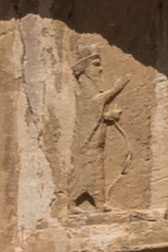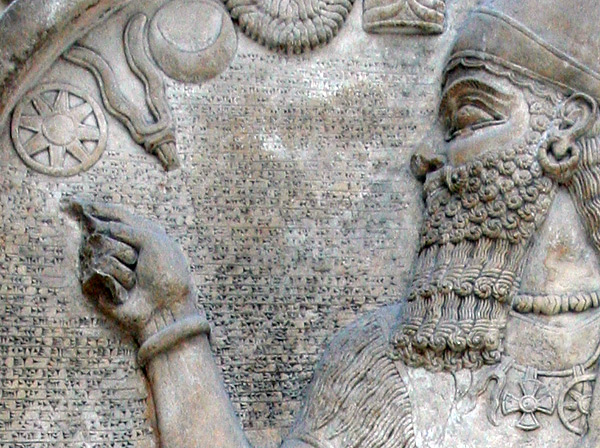|
Aššur-nādin-šumi
Aššur-nādin-šumi (, meaning " Ashur gives a name") was a son of the Neo-Assyrian king Sennacherib and was appointed by him as the king of Babylon, ruling southern Mesopotamia from 700 BC to his capture and execution by the Elamites in 694 BC. Aššur-nādin-šumi was probably Sennacherib's firstborn son and his first crown prince and thus the designated successor to the Assyrian throne. Biography Babylonia had been conquered by the Neo-Assyrian Empire by Tiglath-Pileser III (745–727 BC) less than thirty years before Aššur-nādin-šumi became its king. During these thirty years, Babylonia had repeatedly attempted to once more become an independent kingdom. Babylonian revolts became an especially frequent nuisance during the reign of Sennacherib, who had to defeat numerous southern revolts throughout his reign. After defeating uprisings in 700 BC, Sennacherib named his own son, Aššur-nādin-šumi, as the new king of Babylon. Aššur-nādin-šumi was also titled as , a ... [...More Info...] [...Related Items...] OR: [Wikipedia] [Google] [Baidu] |
Esarhaddon
Esarhaddon, also spelled Essarhaddon, Assarhaddon and Ashurhaddon (, also , meaning " Ashur has given me a brother"; Biblical Hebrew: ''ʾĒsar-Ḥaddōn'') was the king of the Neo-Assyrian Empire from 681 to 669 BC. The third king of the Sargonid dynasty, Esarhaddon is most famous for his conquest of Egypt in 671 BC, which made his empire the largest the world had ever seen, and for his reconstruction of Babylon, which had been destroyed by his father. After Sennacherib's eldest son and heir Aššur-nādin-šumi had been captured and presumably executed in 694, the new heir had originally been the second eldest son, Arda-Mulissu, but in 684, Esarhaddon, a younger son, was appointed instead. Angered by this decision, Arda-Mulissu and another brother, Nabû-šarru-uṣur, murdered their father in 681 and planned to seize the Neo-Assyrian throne. The murder, and Arda-Mulissu's aspirations of becoming king himself, made Esarhaddon's rise to the throne difficult and he first ... [...More Info...] [...Related Items...] OR: [Wikipedia] [Google] [Baidu] |
Sennacherib
Sennacherib ( or , meaning "Sin (mythology), Sîn has replaced the brothers") was the king of the Neo-Assyrian Empire from 705BC until his assassination in 681BC. The second king of the Sargonid dynasty, Sennacherib is one of the most famous Assyrian kings for the role he plays in the Hebrew Bible, which describes his Sennacherib's campaign in the Levant, campaign in the Levant. Other events of his reign include his destruction of the city of Babylon in 689BC and his renovation and expansion of the last great Assyrian capital, Nineveh. Although Sennacherib was one of the most powerful and wide-ranging Assyrian kings, he faced considerable difficulty in controlling Babylonia, which formed the southern portion of his empire. Many of Sennacherib's Babylonian troubles stemmed from the Chaldean tribal chief Marduk-apla-iddina II, who had been List of kings of Babylon, Babylon's king until Sennacherib's father defeated him. Shortly after Sennacherib inherited the throne in 705BC ... [...More Info...] [...Related Items...] OR: [Wikipedia] [Google] [Baidu] |
List Of Kings Of Babylon
The king of Babylon (Akkadian language, Akkadian: , later also ) was the ruler of the ancient Mesopotamian city of Babylon and its kingdom, Babylonia, which existed as an independent realm from the 19th century BC to its fall in the 6th century BC. For the majority of its existence as an independent kingdom, Babylon ruled most of southern Mesopotamia, composed of the ancient regions of Sumer and Akkad (region), Akkad. The city experienced two major periods of ascendancy, when Babylonian kings rose to dominate large parts of the Ancient Near East: the First Babylonian Empire (or Old Babylonian Empire, 1894/1880–1595 BC) and the Second Babylonian Empire (or Neo-Babylonian Empire, 626–539 BC). Babylon was ruled by Hammurabi, who created the Code of Hammurabi. Many of Babylon's kings were of foreign origin. Throughout the city's nearly two-thousand year history, it was ruled by kings of native Babylonian (Akkadian), Amorites, Amorite, Kassites, Kassite, Elamite, Arameans, Aramean, ... [...More Info...] [...Related Items...] OR: [Wikipedia] [Google] [Baidu] |
King Of Babylon
The king of Babylon ( Akkadian: , later also ) was the ruler of the ancient Mesopotamian city of Babylon and its kingdom, Babylonia, which existed as an independent realm from the 19th century BC to its fall in the 6th century BC. For the majority of its existence as an independent kingdom, Babylon ruled most of southern Mesopotamia, composed of the ancient regions of Sumer and Akkad. The city experienced two major periods of ascendancy, when Babylonian kings rose to dominate large parts of the Ancient Near East: the First Babylonian Empire (or Old Babylonian Empire, 1894/1880–1595 BC) and the Second Babylonian Empire (or Neo-Babylonian Empire, 626–539 BC). Babylon was ruled by Hammurabi, who created the Code of Hammurabi. Many of Babylon's kings were of foreign origin. Throughout the city's nearly two-thousand year history, it was ruled by kings of native Babylonian (Akkadian), Amorite, Kassite, Elamite, Aramean, Assyrian, Chaldean, Persian, Greek and Parthian origin. ... [...More Info...] [...Related Items...] OR: [Wikipedia] [Google] [Baidu] |
Babylonia
Babylonia (; , ) was an Ancient history, ancient Akkadian language, Akkadian-speaking state and cultural area based in the city of Babylon in central-southern Mesopotamia (present-day Iraq and parts of Kuwait, Syria and Iran). It emerged as an Akkadian-populated but Amorites, Amorite-ruled state . During the reign of Hammurabi and afterwards, Babylonia was retrospectively called "the country of Akkad" ( in Akkadian), a deliberate archaism in reference to the previous glory of the Akkadian Empire. It was often involved in rivalry with the older ethno-linguistically related state of Assyria in the north of Mesopotamia and Elam to the east in Ancient Iran. Babylonia briefly became the major power in the region after Hammurabi (floruit, fl. –1752 BC middle chronology, or –1654 BC, short chronology timeline, short chronology) created a short-lived empire, succeeding the earlier Akkadian Empire, Third Dynasty of Ur, and Old Assyrian Empire. The Babylonian Empire rapidly fell apar ... [...More Info...] [...Related Items...] OR: [Wikipedia] [Google] [Baidu] |
690s BC Deaths
69 may refer to: * 69 (number) * A year, primarily 69 BC, AD 69, 1969, or 2069 *69 (sex position) *69 Hesperia, a main-belt asteroid Arts and media Music * ''69'', a 1988 album by A.R. Kane * 69", a song by Deep Purple from ''Abandon'' * Major 6 add 9, a jazz chord * "Summer of '69", a song by Bryan Adams * 6ix9ine, also known as Tekashi69, American rapper * ''Day69'', album by 6ix9ine * "69", a song by T-Pain from his 2007 album ''Epiphany'' * ''Six/Nine'', a 1995 album by Buck-Tick Other media * ''69'', a novel by Ryu Murakami * ''69'', a 2004 film based on the Murakami novel Other uses * Lake 69, a small lake in the region of Áncash, Peru * *69, the Last Call Return feature code in the US and Canada * List of highways numbered 69 ** Texas State Highway 112, formerly designated as State Highway 69 * ♋️, the symbol for the astrological sign Cancer * British Rail Class 69, a class of locomotive converted from the ageing British Rail Class 56. See also * "34+35 "34 ... [...More Info...] [...Related Items...] OR: [Wikipedia] [Google] [Baidu] |
Military History Of The Neo-Assyrian Empire
The Neo-Assyrian Empire arose in the 10th century BC. Ashurnasirpal II is credited for utilizing sound strategy in his wars of conquest. While aiming to secure defensible frontiers, he would launch raids further inland against his opponents as a means of securing economic benefit, as he did when campaigning in the Levant. The result meant that the economic prosperity of the region would fuel the Assyrian war machine.Healy, ''The Ancient Assyrians'', p. 10 Ashurnasirpal II was succeeded by Shalmaneser III. Although he campaigned for 31 years of his 35-year reign, he failed to achieve or equal the conquests of his predecessor,Healy, ''The Ancient Assyrians'', p. 13 and his death led to another period of weakness in Assyrian rule. Assyria would later recover under Tiglath-Pileser III, whose reforms once again made Assyria the most powerful force in the Near East,Healy, ''The Ancient Assyrians'', p. 17 and transformed it into a fully fledged empire – the first of its kind. Later, ... [...More Info...] [...Related Items...] OR: [Wikipedia] [Google] [Baidu] |
Sippar
Sippar (Sumerian language, Sumerian: , Zimbir) (also Sippir or Sippara) was an ancient Near Eastern Sumerian and later Babylonian city on the east bank of the Euphrates river. Its ''Tell (archaeology), tell'' is located at the site of modern Tell Abu Habbah near Yusufiyah in Iraq's Baghdad Governorate, some north of Babylon and southwest of Baghdad. The city's ancient name, Sippar, could also refer to its sister city, Sippar-Amnanum (located at the modern site of Tell ed-Der); a more specific designation for the city here referred to as Sippar was Sippar-Yaḫrurum (Sippar-Jaḫrurum). The name comes from the Amorite Yaḫrurum tribe that lived in the area along with the Amorite Amnanum tribe. In Sippar was the site where the Babylonian Map of the World was found. History While pottery finds indicate that the site of Sippar was in use as early as the Uruk period, substantial occupation occurred only in the Early Dynastic Period (Mesopotamia), Early Dynastic and Akkadian Empire pe ... [...More Info...] [...Related Items...] OR: [Wikipedia] [Google] [Baidu] |
Chaldea
Chaldea () refers to a region probably located in the marshy land of southern Mesopotamia. It is mentioned, with varying meaning, in Neo-Assyrian cuneiform, the Hebrew Bible, and in classical Greek texts. The Hebrew Bible uses the term (''Kaśdim'') and this is translated as ''Chaldaeans'' in the Greek Old Testament. During a period of weakness in the East Semitic-speaking kingdom of Babylonia, new tribes of West Semitic-speaking migrants arrived in the region from the Levant between the 11th and 9th centuries BC. The earliest waves consisted of Suteans and Arameans, followed a century or so later by the Kaldu, a group who became known later as the Chaldeans or the Chaldees. These migrations did not affect the powerful kingdom and empire of Assyria in Upper Mesopotamia, which repelled these incursions. These nomadic Chaldeans settled in the far southeastern portion of Babylonia, chiefly on the left bank of the Euphrates. Though for a short time the name commonly referred ... [...More Info...] [...Related Items...] OR: [Wikipedia] [Google] [Baidu] |
Assur
Aššur (; AN.ŠAR2KI, Assyrian cuneiform: ''Aš-šurKI'', "City of God Aššur"; ''Āšūr''; ''Aθur'', ''Āšūr''; ', ), also known as Ashur and Qal'at Sherqat, was the capital of the Old Assyrian city-state (2025–1364 BC), the Middle Assyrian Empire (1363–912 BC), and for a time, of the Neo-Assyrian Empire (911–609 BC). The remains of the city lie on the western bank of the Tigris River, north of the confluence with its tributary, the Little Zab, in what is now Iraq, more precisely in the al-Shirqat District of the Saladin Governorate. Occupation of the city itself continued for approximately 3,000 years, from the Early Dynastic Period to the mid-3rd century AD, when the city was sacked by the Sasanian Empire. The site is a World Heritage Site and was added to that organisation's list of sites in danger in 2003 as a result of a proposed dam, which would flood some of the site. It has been further threatened by the conflict that erupted following the US-led ... [...More Info...] [...Related Items...] OR: [Wikipedia] [Google] [Baidu] |






